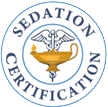Moderate Sedation short explanation
By Ron Eslinger, CRNA
Nursing Service personnel are involved with managing the nursing care of patients receiving sedation or analgesic medications while undergoing invasive diagnostic or therapeutic procedures. Medication administration, patient monitoring, discharge instructions, family teaching and patient safety concerns are all nursing care critical elements of patients undergoing conscience sedation.
Sedation is also referred to as I.V. Sedation, Conscious Sedation, Moderate Sedation, Safe Sedation, Procedural Sedation, Deep Sedation, Computer Assisted Personalized Sedation (CAPS) and Nurse Administered Propofol (NAPs).
Places where nurses may administer sedation to patients is in the Emergency Room, Trauma Center, Post Anesthesia Care Unit (PACU), Operating Room, Surgery Center, Special Procedures, Gastroenterology, Endoscopy, Radiology, Ophthalmology, and Critical Care Unit.
The most common medications used in sedation are Versed, Fentanyl, Morphine and Demerol. Propofol and Ketamine are commonly used for sedation and deep sedation by Certified Registered Nurse Anesthetists and Anesthesiologists. Both Propofol and Ketamine are controversial drugs when considered for use by non-anesthesia trained RNs.
